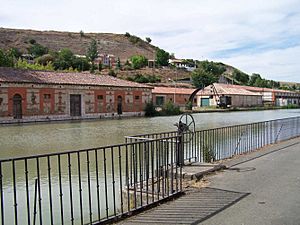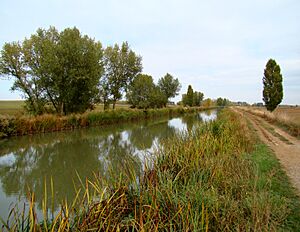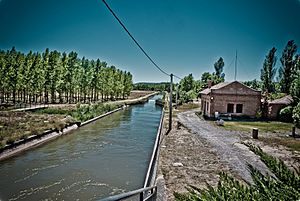Canal de Castilla facts for kids

The Canal of Castile (called Canal de Castilla in Spanish) is a long, old canal in northern Spain. It was built a long time ago, between the late 1700s and early 1800s. This amazing waterway stretches for 207 kilometers (about 128 miles) through three Spanish provinces: Burgos, Palencia, and Valladolid. These provinces are all part of the Autonomous Community of Castile and León.
The canal is usually between 11 and 22 meters (36 to 72 feet) wide. Its depth is about 1.8 to 3 meters (6 to 10 feet). This historic canal is very important. It was declared a "Cultural Interest Asset" in 1991, which means it's protected. Even today, parts of it are still used to water farms and fields in 48 different towns.
History of the Canal

The idea for the Canal of Castile came from the Marques de la Ensenada. This was during the time of King Fernando VI of Spain. The main goal was to help trade. Farmers in a region called Tierra de Campos grew a lot of wheat. The canal would let them transport their wheat from Castile to the northern port of Santander. From there, the wheat could be sent to other markets.
The canal also helped bring goods from Spanish colonies into Castile. The original plan was for the canal to be much longer, about 400 kilometers (250 miles). It was even meant to reach the Bay of Biscay on the coast.
However, building the canal was very difficult. The Spanish War of Independence caused delays. There wasn't enough money, and the Cantabrian Mountains were hard to build through. Because of these problems, the canal never reached the Bay of Biscay.
Its construction took almost 100 years, from 1753 to 1849. The project finally stopped when railroads started to be built in northern Spain. Trains were much faster and more efficient than canals for transport.
The canal was most used between 1850 and 1870. During this time, up to 400 barges (flat-bottomed boats) traveled on it. These barges were pulled by animals walking on a towpath next to the water. Later, the canal became more important for watering crops. It was not as good for transport as trains. The special water gates, called locks, on the canal were closed in the 1900s.
The canal looks like an upside-down 'Y' shape. It connects three main places. It starts in Alar del Rey (in Palencia). This is the beginning of the Northern Branch. The other ends are Valladolid (for the Southern Branch) and Medina de Rioseco (for the Campos Branch).
Nature and Wildlife
The areas around the Canal of Castile are very important for birds. In the Tierra de Campos region, there are two large "Special Protection Areas." These are called La Nava-Campos Norte and La Nava-Campos Sur. They are famous for birds like the great bustard. These birds live in dry farming areas, sometimes called "steppes," which are common in this region.
The canal itself is a great home for wetland birds. One example is the bittern, a type of heron. The canal also gives its name to two "Sites of Community Importance." These are places protected for their natural value:
- A wooded part of the canal near Osorno la Mayor is protected. It's called Canal de Castilla and covers 150 hectares (about 370 acres).
- Several wetlands, some very small, are protected as Lagunas del Canal de Castilla. This area covers 71 hectares (about 175 acres). It's a special place for nature.
From 2006 to 2010, a program called the Life Programme helped restore wetlands in the province of Palencia. The goal was to make the canal even better for nature and wildlife.
Some of the birds that benefited from this project include:
- The aquatic warbler: This small bird is Europe's most endangered songbird. It uses Spain as a migration route on its long journeys.
- The bittern: This wetland bird found a better home thanks to the improvements.
The project also added places for people to watch birds. Two new observatories were built near wetlands where many interesting birds can be seen. These are at Venta de Valdemudo (Becerril de Campos) and Valdemorco (Boadilla del Camino). They join an observatory that was already there in Toja de las Ribas (Ribas de Campos).
Images for kids
-
Campos Branch of Canal de Castilla (Medina de Rioseco).
See also
 In Spanish: Canal de Castilla para niños
In Spanish: Canal de Castilla para niños



